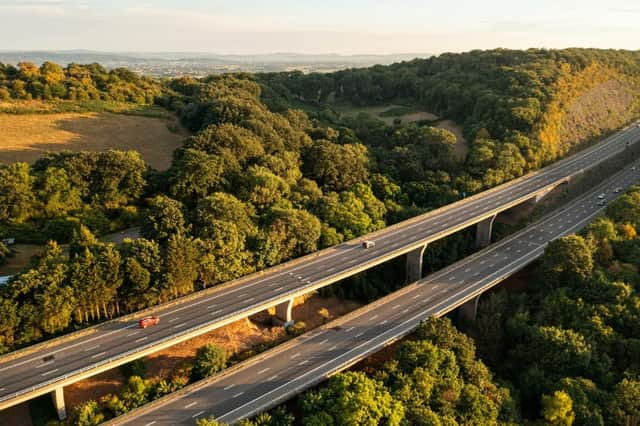New proposals for motorways and A-roads in Sussex and beyond: action to cut carbon emissions ‘at every opportunity’


They are part of plans to connect the country and grow the economy in an environmentally sustainable way.
The Strategic Road Network Initial Report for 2025-2030 sets out National Highways’ advice to the government on priorities over the next five years and beyond.
Advertisement
Hide AdAdvertisement
Hide AdRoads Minister Richard Holden said: “Our roads are vital to our economy, and the plans set out today will help to enhance connectivity and boost growth, while protecting the environment. Working with National Highways, we are committed to delivering safe, reliable journeys and reducing congestion in a way supports our path to net zero.”
The report, which was released on Thursday, May 18, says National Highways’ work will likely increase focus on making the most of its existing network through proactive maintenance and improvement works. Some of the goals include boosting safety and journey reliability. This includes getting the network ready for connected and autonomous vehicles and encouraging active travel through greater use of digital technologies.
The report also explains the challenges facing busy roads that were built in the 1960s and 70s and how investment can help tackle congestion.
The Initial Report is set to be subject to an eight-week consultation by the Department for Transport. It is published alongside National Highways’ long-term strategic plan, Connecting the Country, which outlines the company’s priorities for the network up to 2050.
Advertisement
Hide AdAdvertisement
Hide AdThese are the proposals outlined in the Initial Report, according to National Highways:
A continued focus on safety, targeting a reduction in fatalities and serious injuries through interventions such as targeted upgrades to single carriageway A-roads, initially focusing on 17 routes covering 147 miles.
Increasing investment in small local schemes – those valued £2m to £25m – to spread opportunity and tackle known safety and congestion issues, often via improved slip roads and junctions connecting to local roads.
Providing road users with more real-time and personalised information covering congestion, on-going incidents, planned roadworks, events and the availability of electric vehicle charging points, giving them alternative routes if necessary.
Advertisement
Hide AdAdvertisement
Hide AdA greater focus on improving journey experiences, including considering lorry parking facilities as part of the design and planning of projects where a need is identified.
Enabling the transition to zero carbon motoring by supporting the installation of around 2,500 open-access rapid charge points for electric vehicles on the network by 2030.
Continuing to invest in infrastructure for non-motorised users such as walkers, cyclists and horse risers, including possibly acquiring more land to create physically segregated ‘link’ paths and cycle lanes alongside and away from the highway.
Increasing proactive maintenance with the aim of reducing large repairs and disruption on the network, while also driving efficiency and roadworker safety through the increased use of autonomous plant on work sites.
Advertisement
Hide AdAdvertisement
Hide AdMaximising opportunities to support biodiversity through initiatives such as the planting of an additional three million trees up to 2030.
Most importantly, National Highways proposes cutting carbon emissions ‘at every opportunity’. They said that by 2030, maintenance and construction emissions will be cut by up to 50 per cent by ‘minimising new works, using lean construction practices and carbon management approaches’.
A National Highways spokesperson said: “The company’s own corporate emissions will also be cut to net zero by 2030 – without the use of purchased offsetting – through the transition to renewable energy, converting most road lighting to low-energy LEDs and other initiatives such as transitioning all traffic officer vehicles to electric power. Facilitating the shift to electric vehicles through the installation of additional charge points will help deliver the UK’s climate change commitments while improving air quality for communities close to the network.”